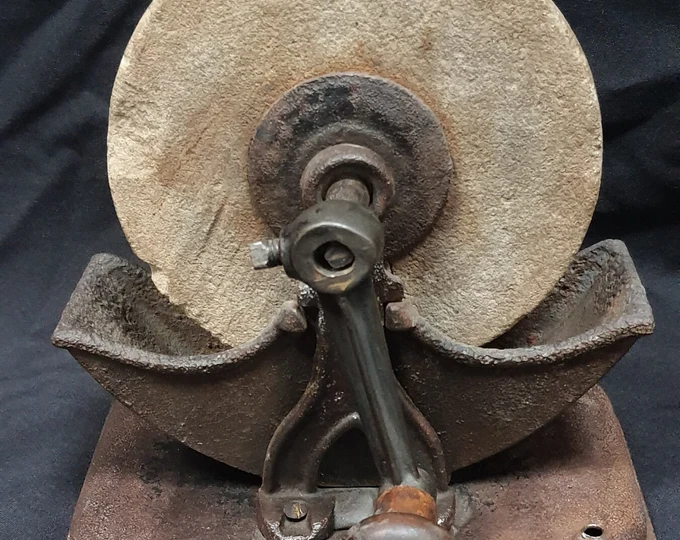This Thing Surprised Me

Source: eBay
I never intended to fall head over heels for a hand-cranked whetstone, but that’s precisely what happened one idle Saturday afternoon while rummaging through a flea market. You know the type: smells of dusty antiques and fried doughsticks. Nirvana.
I was riffling through a pile of rusted wrenches when I noticed it. Just sitting there, on a table, like it had waited for someone to recall what it was: a hand-cranked whetstone. A big, stone wheel, cast-iron base, and crank that had not turned for decades.
Then and there, I was whisked away to my grandfather’s barn, where a hand-cranked whetstone awaited its use.
The Hard Way to Sharpen (The Best Way)
We had one of these in the shed behind the house when I was growing up and my grandfather called it the “wheel.” He never needed to clarify that. We all knew what he meant. It was low to the ground, with a puddle bucket next to, and if you were lucky, a stool that didn’t wobble.
I would watch him crank that stone like he was turning the very axis of the earth – slow, steady, sparks sometimes flying when he found the rhythm on the hand-cranked whetstone. He sharpened everything on that thing: hatchets, chisels, knives, and even lawn mower blades when he had enough patience to do it.
There was no electricity, no battery, just elbow grease and an eye. I certainly didn’t have this at nine years old. But boy, did I want it.

When I came across this smaller tabletop version, a hand-cranked whetstone with “C S Co.” stamped in the side, I knew it had a story. Probably late 1800s or early 1900s, possibly from the Cleveland Stone Company, who produced a ton of these sandstone wheels back when.
Why These Tools Matter
You may be asking “why would anyone want this today?” And fair enough. We have nice electric grinders, diamond whetstones, knife sharpeners that will do the job with just a few pulls. But sometimes slow is satisfying.
Cranking the wheel, feeling the grind, watching the blade return to life is more than sharpening. It’s therapeutic, sure it’s a little noisy, and makes a mess if you’re not careful (trust me), but there is a rhythm to it that feels good. Like you’re being connected to something older and solid.
This one works just like it did decades ago. I cleaned this one up, gave it a spin, and it spun just like it was waiting to be turned. I even put a hatchet on it just for fun — not the best job but the edge was wicked sharp.
The Little Details That Tell A Story
This is what I love about old tools, they tell a story or they can wear their story. This one has grooves in the stone from years of sharpening. The crank has a few polished spots where a hand was gripping it tight time and again. And there’s a even a slight dark stain on the base that must be oil or some metal filings that found a permanent place to settle.
You won’t find this kind of character in a new tool. This type of tool is not a one and done type of tool, it’s one you would want to pass down, or at very least, leave it in the garage for your kids and someday, your grand kids, to find it and say “What the hell is this thing?”

Wrapping It Up (With Some Advice)
If you ever come across a hand-cranked whetstone at a yard sale or antique store, get. it. Clean it, give it a crank, see if it works. If it does, even if you don’t use it every week, it’s a conversation starter, a piece of history. Also, if you need it they do a nice job sharpening will put a nice edge on an edge tool in a pinch.
Just don’t use it on your kitchen scissors. I know from experience this won’t end well.
So, maybe I’m getting sentimental, maybe I’m a sucker for heartbreak and old stories, I’d choose one old tool any day, one old whetstone instead of any plastic tool you can get at your local hardware store. Sometimes keeping that edge sharp might not be what you think – quick and efficient.
Sometimes it’s just old timey.